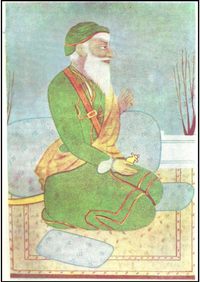Dewan Mokham Chand
Dewan Mokham Chand | |
|---|---|
 | |
| Born | 1750 |
| Died | 29 October 1814 |
| Occupation | Military officer |
| Children | Diwan Moti Ram |
Dewan Mokham Chand (died 29 October 1814) was a general of Ranjit Singh, the ruler of the Sikh Empire.
Early life[edit]
Mokham Chand was born in a Hindu Khatri family,[1] to Vaisakhi Mal, a tradesman of the village Kunjah near Gujrat.[2]
Military career[edit]
Mokham Chand was the most distinguished general of Ranjit Singh.[3]
Ranjit Singh had seen him in action at Akalgarh three years earlier and again in the fight against the Bhangi Sardar of Gujrat. Mokham Chand had fallen out with the Bhangi and came to Ranjit Singh upon his request. Ranjit welcomed him with handsome gifts of an elephant and horses and granted him the Dallewalia possessions as a Jagir. He was made commander of a cavalry unit with the power to recruit 1500 foot soldiers as well.[2]
In the beginning of 1808 various places in the Upper Punjab were taken from their independent Sikh proprietors, and brought under the direct management of the new kingdom of Lahore, and Mokham Chand was at the same time employed in effecting a settlement of the territories which had been seized on the left bank of the Sutlej. But Ranjit Singh’s systematic aggression had begun to excite fear in the minds of the Sikhs of Sirhind[4]
He was the commander in chief of armies in Battle of Attock which defeated Durrani Empire Wazir Fateh Khan and Dost Mohammad Khan. With the permission of the Maharaja, the Sikh forces attacked the Afghans on 12 July 1813 at Hazro, about 8 kilometers from Attock. This battle is also known as the battle of Chhuchh. Terrible fighting took place between the adversaries. In the meantime, Afghans received fresh reinforcements under Dost Muhammad Khan.[5] }} The Diwan left his elephant, mounted a horse and personally leading his reserves fell upon the disorganized Afghans. Hand to hand fighting took place and there were heavy losses on both sides. Diwan Amar Nath mentions that 2,000 Afghans were killed. Dost Muhammad was seriously wounded. Many Afghans drowned in the Indus and a large number were taken prisoner. The Sikhs plundered the provisions of the Afghans. Besides Diwan Mohkam Chand, Jodh Singh Kalsia and Fateh Singh Ahluwalia, Sardar Dal Singh, Diwan Ram Dayal also took part in fighting against Afghans at Hazro. Fateh Khan fled away to Peshawar. Thus the victory for the Sikhs was complete. The credit for this major triumph goes to the dynamic generalship of Diwan Mohkam Chand. Hukam Singh Chimni was appointed Qiladar of the fort of Attock. [6][7]
Death and successors[edit]
He died at Phillaur on 29 October 1814, on a Saturday. His son Diwan Moti Ram and grandsons Diwan Kirpa Ram and Diwan Ram Dayal (appointed as Governor of Attock)[8] who too rendered meritorious services to the Sikh State. He was one of the architects of the Sikh empire who rose by dint of merit to the post of Diwan and virtually the commander-in-chief of the Sikh forces. N. K. Sinha observes. "As a general, he was uniformly successful and from 1806 to 1814 the annexation of Ranjit Singh was due not only to his irresistible cunning but also to Mohkam Chand's military talents." Ranjit Singh always held him in high esteem. He had a sound knowledge of military tactics and strategy. He did not suffer a defeat; he was an ever victorious General.
See also[edit]
References[edit]
- ↑ Ansar Hussain Khan (1999). Rediscovery of India, The: A New Subcontinent. Orient Blackswan. p. 153. ISBN 978-81-250-1595-6.
- ↑ 2.0 2.1 Khushwant Singh A history of the Sikhs Volume 1 page 217
- ↑ The Punjab Chiefs WL Conran and HD Crank published by Sangameel Publications Pakistan page 156. Quote: "The most distinguished of the generals, by whose skill and courage Ranjit Singh rose from a subordinate chiefship to the Empire of the Punjab, was Diwan Mokham Chand. The sagacity with which the Maharaja selected his officers was reason of his uniform success ..."
- ↑ History of the Sikhs from the Origin of the Nation to the Battles of the Sutlej by Joseph Davey Cunningham, H.L.O. Garrett Page 136
- ↑ Hari Ram Gupta, History of the Sikhs, Vol. V, pp. 110-11 452 Murray, History of the Sikhs, Vol. II, p. 13; Cunningham History of the Sikhs, p. 138. Agrees with this date; Hari Ram Gupta, History of the Sikhs, Vol. V, p. 101, mention Ranjit Singh got the news of this battle on 12 July 1813, from a letter sent from Pind Dadan Khan by Sukh Dayal, an agent of Rama Nand Sahu, stating that the battle was fought on 9 July 1813. According to N. K. Sinha, Ranjit Singh, p. 50. This battle took place on 26 June 1813. 453 Murray, History of the Punjab, Vol. II, p. 13.
- ↑ Singh, J. (2006). Artillery: The Battle-winning Arm. Lancer Publishers & Distributors. p. 42. ISBN 9788176021807. Retrieved 14 April 2015.
- ↑ Griffin, L. (2004). Ranjit Singh and the Sikh Barrier Between Our Growing Empire and Central Asia. Asian Educational Services. p. 192. ISBN 9788120619180. Retrieved 14 April 2015.
- ↑ Kohli, M. S. (2003). Miracles of Ardaas: Incredible Adventures and Survivals. M.L. Gidwani, Indus Publishing Company. p. 25. ISBN 81-7387-152-3. Retrieved 3 April 2018.